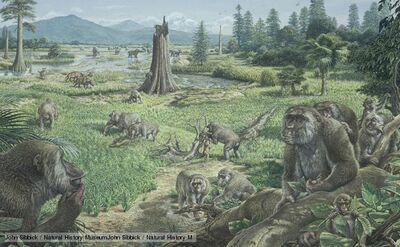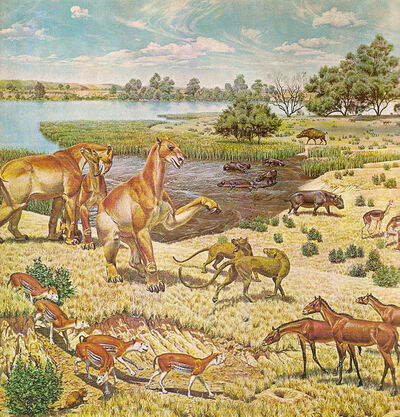
The Miocene is a geological epoch of the Neogene Period and extends from about 23.03 to 5.332 million years ago (Ma). The Miocene was named by Sir Charles Lyell. Its name means "less recent" because it has 18% fewer modern sea invertebrates than the Pliocene. The Miocene follows the Oligocene Epoch and is followed by the Pliocene Epoch. The Miocene is the first epoch of the Neogene Period.
The earth went from the Oligocene Epoch through the Miocene and into the Pliocene as it cooled into a series of Ice Ages. The Miocene boundaries are not marked by a single distinct global event but consist rather of regional boundaries between the warmer Oligocene and the cooler Pliocene.The plants and animals of the Miocene were fairly modern. Mammals and birds were well-established. Whales, seals, and kelp spread. At the end of this epoch, the Himalayas started to rise.
Subdivisions[]
The Miocene faunal stages from youngest to oldest are typically named according to the International Commision of Statigraphy:
Messinian (7.246-5.332 Ma)
Tortonian (11.608-7.246 Ma)
Serravalian (13.65-11.608 Ma)
Langhian (15.97-13.65 Ma)
Burdigalian (20.03-20.43 Ma)
Aquitanian (23.03-20.43 Ma)
These subdivisions within the Miocene are defined by the relative abundance of different species of calcareous nanofossils (calcite platelets shed by brown single-celled algae) and foraminifera (single-celled protists with diagnostic shells). Two subdivisions each form the Early, Middle and Late Miocene.
Paleogeography[]
Continents continued to drift toward their present positions. Of the modern geologic features, only the land bridge between South America and North America was absent, although South America was approaching the western subduction zone in the Pacific Ocean, causing both the rise of the Andes and a southward extension of the Meso-American peninsula.
Mountain building took place in Western North America, Europe, and east Asia. Both continental and marine Miocene deposits are common worldwide with marine outcrops common near modern shorelines. Well studied continental exposures occur in the American Great Plains and in Argentina.
India continued to collide with Asia, creating dramatic new mountain ranges. The Tethys Seaway continued to shrink and then disappeared as Africa collided with Eurasia in the Turkish-Arabian region between 19 and 12 Ma. The subsequent uplift of mountains in the western Mediterranean region and a global fall in sea levels combined to cause a temporary drying up of the Mediterranean Sea (known as the Messinian salinity crisis) near the end of the Miocene.
The global trend was towards increasing aridity caused primarily by global cooling reducing the ability of the atmosphere to absorb moisture. Uplift of East Africa in the Late Miocene was partly responsible for the shrinking of tropical rain forests in that region, and Australia got drier as it entered a zone of low rainfall in the Late Miocene.
Fauna[]
Both marine and continental fauna were fairly modern, although marine mammals were less numerous. Only in isolated South America and Australia did widely divergent fauna exist. In the Early Miocene, several Oligocene groups were still diverse, including nimravids, entelodonts, and three-toed horses. Like in the previous Oligocene epoch, oreodonts were still diverse, only to disappear in the earliest Pliocene. During the later Miocene mammals were more modern, with recognizable dogs, raccoons, horses, beaver, red pandas, deer, camels, and whales, along with now extinct groups like borophagine dogs, gomphotheres, three-toed horses, and semi-aquatic and hornless rhinos like Teleoceras and Aphelops. Islands began to form between South and North America in the Late Miocene, allowing ground sloths like Thinobadistes to island-hop to North America.

Miocene fauna of North America
Unequivocally recognizable dabbling ducks, plovers, typical owls, cockatoos and crows appear during the Miocene. By the epoch's end, all or almost all modern bird families are believed to have been present; the few post-Miocene bird fossils which cannot be placed in the evolutionary tree with full confidence are simply too badly preserved instead of too equivocal in character. Marine birds reached their highest diversity ever in the course of this epoch.Approximately 100 species of apes lived during this time. They ranged over much of the Old World and varied widely in size, diet, and anatomy. Due to scanty fossil evidence it is unclear which ape or apes contributed to the modern hominid clade, but molecular evidence indicates this ape lived from between 15 to 12 million years ago.
In the oceans, Brown algae, called kelp, proliferated, supporting new species of sea life, including otters, fish and various invertebrates. Cetaceans attained their greatest diversity during the Miocene, with over 20 recognized genera in comparison to only six living genera. This diversification correlates with emergence of gigantic macro-predators such as megatoothed sharks and raptorial sperm whales. Prominent examples are C. megalodon and L. melvillei.Crocodilians also showed signs of diversification during Miocene. The largest form among them was a gigantic caiman Purussaurus which inhabited South America. Another gigantic form was a false gharial Rhamphosuchus, which inhabited modern age India. A strange form Mourasuchus also thrived alongside Purussaurus. This species developed a specialized filter-feeding mechanism, and it likely preyed upon small fauna despite of its gigantic size.The pinnipeds, which appeared near the end of the Oligocene, became more aquatic. Prominent genus was Allodesmus.